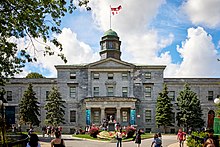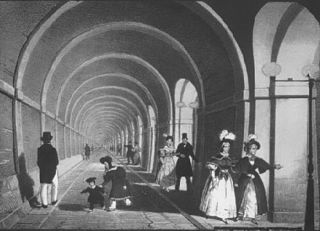This article needs additional citations for verification .(December 2022) |
| |||
|---|---|---|---|
| Buildings and structures +... |
The year 1843 in architecture involved some significant events.
This article needs additional citations for verification .(December 2022) |
| |||
|---|---|---|---|
| Buildings and structures +... |
The year 1843 in architecture involved some significant events.


Sir Marc Isambard Brunel was a French-British engineer who is most famous for the work he did in Britain. He constructed the Thames Tunnel and was the father of Isambard Kingdom Brunel.

A tunnelling shield is a protective structure used during the excavation of large, man-made tunnels. When excavating through ground that is soft, liquid, or otherwise unstable, there is a potential health and safety hazard to workers and the project itself from falling materials or a cave-in. A tunnelling shield can be used as a temporary support structure. It is usually in place for the short-term from when the tunnel section is excavated until it can be lined with a permanent support structure. The permanent structure may be made up of, depending on the period, bricks, concrete, cast iron, or steel. Although modern shields are commonly cylindrical, the first "shield", designed by Marc Isambard Brunel, was actually a large, rectangular, scaffold-like iron structure with three levels and twelve sections per level, with a solid load-bearing top surface. The structure protected the men from cave-ins as they laboured within it, digging the tunnel out in front of the shield.

The Thames Tunnel is a tunnel beneath the River Thames in London, connecting Rotherhithe and Wapping. It measures 35 ft (11 m) wide by 20 ft (6.1 m) high and is 1,300 ft (400 m) long, running at a depth of 75 ft (23 m) below the river surface measured at high tide. It is the first tunnel known to have been constructed successfully underneath a navigable river. It was built between 1825 and 1843 by Marc Brunel and his son Isambard using the tunnelling shield newly invented by the elder Brunel and Thomas Cochrane.
Peter William Barlow was an English civil engineer, particularly associated with railways, bridges, the design of tunnels and the development of tunnelling techniques. In 1864 he patented a design for a cylindrical tunnelling shield, and obtained a provisional patent in 1868 for an improved design.

The year 1843 in science and technology involved some significant events, listed below.

Henry Marc Brunel was an English civil engineer and the son of the celebrated engineer Isambard Kingdom Brunel and grandson of civil engineer Marc Isambard Brunel.
The year 1806 in architecture involved some significant events.
The year 1864 in architecture involved some significant architectural events and new buildings.
The year 1840 in architecture involved some significant architectural events and new buildings.

Maidenhead Railway Bridge, also known as Maidenhead Viaduct and The Sounding Arch, carries the Great Western Main Line (GWML) over the River Thames between Maidenhead, Berkshire and Taplow, Buckinghamshire, England. It is a single structure of two tall wide red brick arches buttressed by two over-land smaller arches. It crosses the river on the Maidenhead-Bray Reach which is between Boulter's Lock and Bray Lock and is near-centrally rooted in the downstream end of a very small island.

The Brunel Museum is a small museum situated at the Brunel Engine House, Rotherhithe, London Borough of Southwark. The Engine House was designed by Sir Marc Isambard Brunel as part of the infrastructure of the Thames Tunnel which opened in 1843 and was the first tunnel to be built under a navigable river anywhere in the world. It comprises the Engine House and the Tunnel Shaft, with rooftop garden. Isambard Kingdom Brunel worked with his father on the project from 1823 and was appointed Resident Engineer in January 1827 at the age of 20.

Isambard Kingdom Brunel was an English civil engineer and mechanical engineer, who is considered "one of the most ingenious and prolific figures in engineering history," "one of the 19th-century engineering giants", and "one of the greatest figures of the Industrial Revolution, [who] changed the face of the English landscape with his groundbreaking designs and ingenious constructions". Brunel built dockyards, the Great Western Railway (GWR), a series of steamships including the first purpose-built transatlantic steamship, and numerous important bridges and tunnels. His designs revolutionised public transport and modern engineering.
Sophia Kingdom, later known as Lady Brunel, was the mother of Isambard Kingdom Brunel. Her father was William Kingdom, a contracting agent for the Royal Navy and the army, and her mother was Joan Spry. She was born in Plymouth, England. She was the youngest of sixteen children. When she was eight years old, her father William died (1783).
Events from the year 1843 in the United Kingdom.
Thomas Page was a British architect and civil engineer who was responsible for the design and construction of many bridges, including Westminster Bridge and the first Chelsea Bridge
The Thames Archway Company was a company formed in 1805 to build the first tunnel under the Thames river in London.
William Gravatt FRS, was a noted English civil engineer and scientific instrument maker.

A bronze statue of Isambard Kingdom Brunel, also known as Brunel Monument or the Isambard Brunel Monument, by Carlo Marochetti, stands on the Victoria Embankment in London, England, at the west end of Temple Place. The statue rests on a Portland stone pedestal, with flanking screens and benches, by the architect Richard Norman Shaw.

Michael Lane was a British civil engineer who served as the Chief Engineer of the Great Western Railway (GWR). A protégé of Isambard Kingdom Brunel, he worked with both Brunel and Brunel's father Marc on various projects before joining the younger Brunel on the GWR. He eventually succeeded that Brunel as the railway's Chief Engineer, serving in the position for nearly eight years before his death.